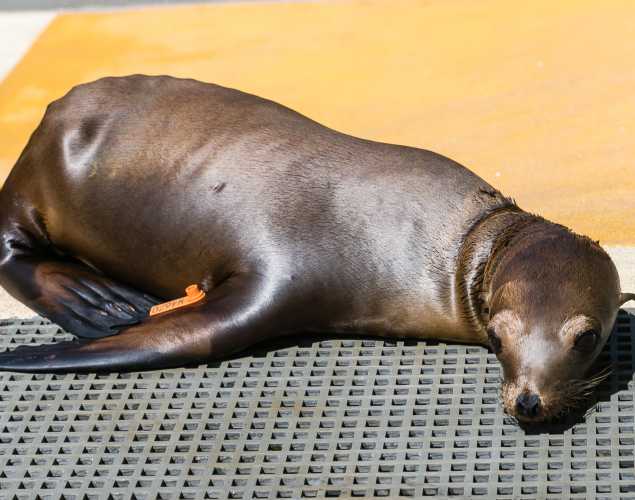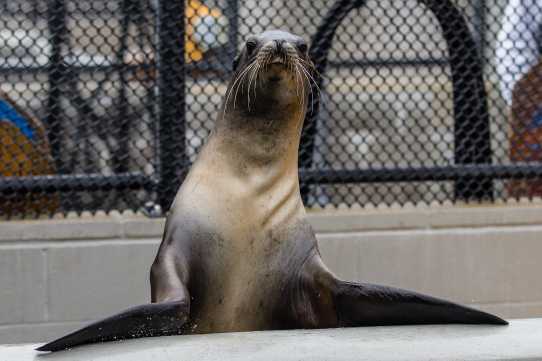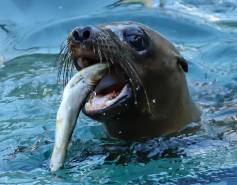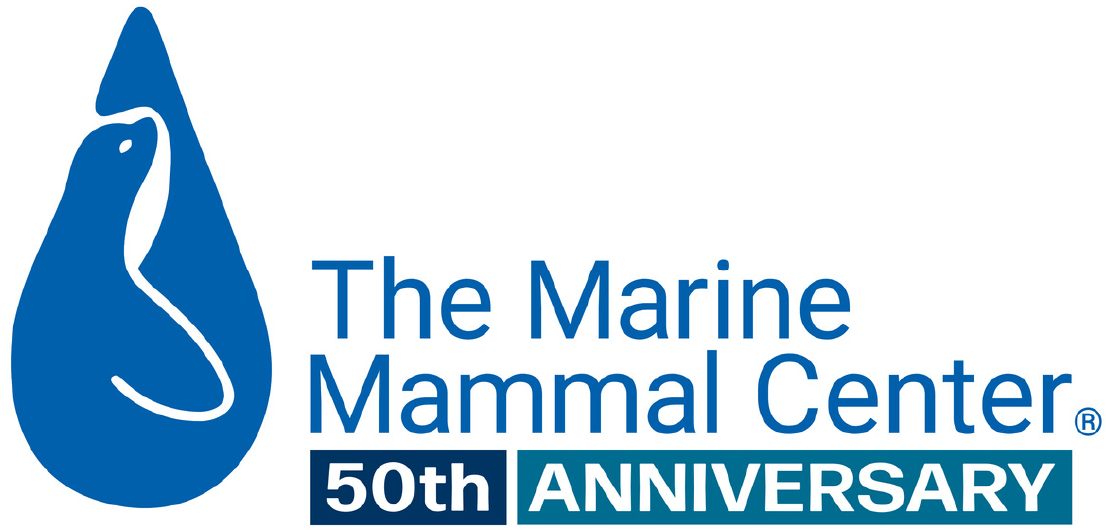
Leptospirosis: Kidney Damage in California Sea Lions
Every four to five years, The Marine Mammal Center sees a surge in the number of California sea lions that are admitted with symptoms of leptospirosis.
This bacterial infection affects the kidneys and can be lethal. If not treated, the bacteria can cause irreversible kidney damage.
What Is Leptospirosis?
Leptospirosis is caused by a spiral-shaped bacteria called Leptospira. Veterinarians can usually identify leptospirosis in a patient even before laboratory tests confirm a diagnosis because of the infection's distinctive symptoms in California sea lions, which include drinking water and folding the flippers over the abdomen.
Marine mammals generally do not need to drink water because they receive all the hydration they need from food sources. But when they are infected with the Leptospira, their kidneys stop functioning properly and cannot filter toxins or regulate hydration.
Sea lions diagnosed with leptospirosis are treated with antibiotics, fluids and other supportive care, such as gastroprotectants for stomach and intestinal ulcers. Unfortunately, even with treatment, roughly two-thirds of the animals that strand with acute leptospirosis do not survive.
Meet One of Our Patients
California sea lion Argus was rescued just a few miles from The Marine Mammal Center near a busy marina. Our veterinary experts determined that he was suffering from leptospirosis, a bacterial infection of the kidneys.
Argus was one of several dozen California sea lions we treated for leptospirosis in 2017, a serious disease that can also infect humans. What our scientists learn from treating patients like Argus helps us better understand how this disease is transmitted and how to protect human health as well.
Once Argus had recovered fully from the disease, he was released back to the wild just steps from our hospital.

Leptospirosis is a major health burden for humans, domestic animals and wildlife worldwide with about one million severe cases in humans every year. Leptospira can cause disease ranging from infection with no symptoms to severe and possibly fatal disease.
When a leptospirosis outbreak occurs, our scientists study the disease to learn more about what causes an outbreak and how we can improve treatment for infected animals. Thanks to the Center’s long history of stranding records and bank of blood and urine samples, researchers have a unique opportunity to investigate the disease patterns over many decades.
Leptospira was first detected in California sea lions in 1970 during a leptospirosis outbreak that occurred along the coast of California, Oregon and Washington. Since the 1980s, we have seen yearly, seasonal outbreaks with major outbreak events causing 100 or more sea lion strandings happening every four to five years.
The reasons for these periodic major outbreaks in sea lions is unknown, however our UCLA collaborators believe that a combination of factors may be responsible, such as changes in herd immunity, sea surface temperatures and sea lion migration patterns.
Leptospirosis Research at The Marine Mammal Center
The Center has been on the forefront of research on leptospirosis in marine mammals and has published a number of scientific papers on the disease dating back to 1985. And for more than 10 years, we’ve collaborated with researchers at UCLA to study the dynamics of this pathogen in the California sea lion population.
{"image":"\/Animals\/Patients\/California sea lions\/cropped-images\/csl-eating-by-bill-hunnewell-c-the-marine-mammal-center-0-361-1799-1405-1617816863.jpg","alt":"California sea lion eating a fish","title":"Predicting Prognosis in Wildlife Rehabilitation: A Case Study of Leptospirosis in Sea Lions","link_url":"https:\/\/www.marinemammalcenter.org\/publications\/predicting-prognosis-in-wildlife-rehabilitation-a-case-study-of-leptospirosis","label":"Research Paper","type":"publication"}

Predicting Prognosis in Wildlife Rehabilitation: A Case Study of Leptospirosis in Sea Lions
Read More{"image":"\/Animals\/Wild\/California sea lion\/cropped-images\/sea-lions-in-water-photo-c-bill-hunnewell-2140-212-1308-1022-1603918234.jpg","alt":"large group of California sea lions in the water","title":"Detecting the Spread of Leptospirosis Through Asymptomatic Carriers","link_url":"https:\/\/www.marinemammalcenter.org\/publications\/detecting-the-spread-of-leptospirosis-through-asymptomatic-carriers","label":"Research Paper","type":"publication"}

{"image":"\/Animals\/Patients\/California sea lions\/cropped-images\/csl-by-bill-hunnewell-c-the-marine-mammal-center-7-0-1446-2827-2208-1603918668.jpg","alt":"California sea lion on pool ledge","title":"Effectiveness of Antibiotics in Treating Leptospirosis in California Sea Lions","link_url":"https:\/\/www.marinemammalcenter.org\/publications\/effectiveness-of-antibiotics-in-treating-leptospirosis-in-california-sea-lions","label":"Research Paper","type":"publication"}

Effectiveness of Antibiotics in Treating Leptospirosis in California Sea Lions
Read More{"image":"\/Animals\/Patients\/California sea lions\/cropped-images\/csl-by-bill-hunnewell-c-the-marine-mammal-center-5-0-1-3112-2431-1603919011.jpg","alt":"California sea lion diving into a pool","title":"First Report of Asymptomatic Carrier Transmission of Leptospirosis","link_url":"https:\/\/www.marinemammalcenter.org\/publications\/first-report-of-asymptomatic-carrier-transmission-of-leptospirosis","label":"Research Paper","type":"publication"}

{"image":"\/Animals\/Wild\/California sea lion\/cropped-images\/sea-lions-underwater-baja-shutterstock-186-4-4173-3260-1603919420.jpg","alt":"California sea lions underwater","title":"Seasonal Migration Contributes to Spread of Leptospirosis","link_url":"https:\/\/www.marinemammalcenter.org\/publications\/seasonal-migration-contributes-to-spread-of-leptospirosis","label":"Research Paper","type":"publication"}

Interestingly, after 30 uninterrupted years of seeing at least a few cases of leptospirosis annually, the disease disappeared from the population in late 2013 only to reappear four years later.
Researchers at UCLA believe the disappearance of the disease may be related to the highly anomalous oceanographic conditions that occurred during the same time period. The abnormally warm waters, commonly referred to as “the Blob,” may have caused changes in sea lion behavior and migration patterns as they struggled to find food sources.
Since 2009, the Center's biologists and veterinary staff have taken blood and urine samples from wild juvenile California sea lions at popular haul-out spots in the San Francisco and Monterey Bay areas. These animals are then tagged and released, and the urine and blood samples help researchers learn more about kidney function and exposure rates among these animals.
This collaborative research project also relies on long-term demographic datasets generated by our partners at the NOAA Fisheries Marine Mammal Laboratory. These biologists monitor and track pups born on the Channel Islands every year. We also work closely with biologists in Oregon and Washington who monitor the sea lions in those areas.
Leptospirosis in the News
{"image":"\/Animals\/Patients\/California sea lions\/2018\/cropped-images\/csl-yakshack-by-bill-hunnewell-c-the-marine-mammal-center-371-6-2212-1728-1701471071.jpg","alt":"California sea lion Yakshack","title":"The Press Democrat: Flurry of Sick and Dying Sea Lions Believed to be Caused by Bacterial Disease","link_url":"https:\/\/www.marinemammalcenter.org\/news\/the-press-democrat-flurry-of-sick-and-dying-sea-lions-believed-to-be-caused-by-bacterial-disease","label":"In the News","date":"2023-09-05 02:00:00","type":"news"}

The Press Democrat: Flurry of Sick and Dying Sea Lions Believed to be Caused by Bacterial Disease
September 5, 2023
Read More{"image":"\/Animals\/Patients\/California sea lions\/2018\/cropped-images\/csl-dangela-by-bill-hunnewell-c-the-marine-mammal-center-0-355-2693-2103-1604444597.jpg","alt":"California sea lion Dangela","title":"San Francisco Chronicle: Sea Lions Battling Deadly Disease","link_url":"https:\/\/www.marinemammalcenter.org\/news\/san-francisco-chronicle-sea-lions-battling-deadly-disease","label":"In the News","date":"2018-10-17 05:00:00","type":"news"}

{"image":"\/Animals\/Patients\/California sea lions\/2018\/cropped-images\/csl-zoltan-by-bill-hunnewell-c-the-marine-mammal-center-0-322-2470-1929-1623277278.jpg","alt":"California sea lion Zoltan","title":"The Marine Mammal Center Responds to Second Largest Leptospirosis Outbreak on Record","link_url":"https:\/\/www.marinemammalcenter.org\/news\/the-marine-mammal-center-responds-to-second-largest-leptospirosis-outbreak-on-record","label":"News Update","date":"2018-10-16 02:00:00","type":"news"}

The Marine Mammal Center Responds to Second Largest Leptospirosis Outbreak on Record
October 16, 2018
Read More{"image":"\/Misc\/cropped-images\/leashed-dog-on-beach-shutterstock-10-10-5572-4352-1696014237.jpg","alt":"a golden retriever lying on a sandy beach with a leash and harness","title":"How to Keep Your Dog Safe on Beaches","link_url":"https:\/\/www.marinemammalcenter.org\/news\/how-to-keep-your-dog-safe-on-beaches","label":"News Update","date":"2023-09-29 02:00:00","type":"news"}

